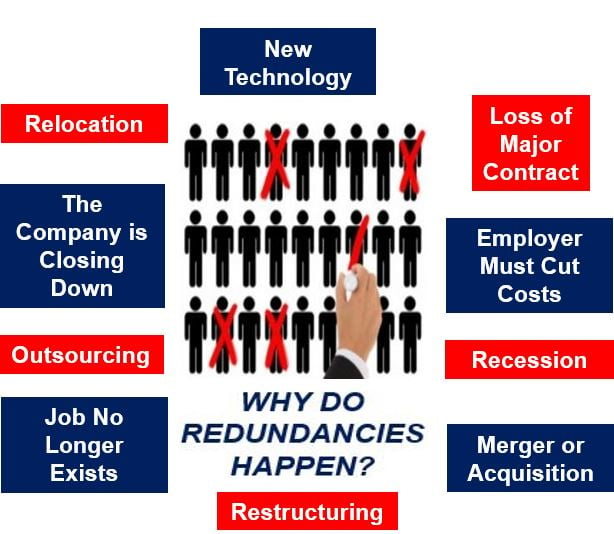Redundancy Pay If Company Goes Bust: Comprehending Your Entitlements in the UK
Redundancy Pay If Company Goes Bust: Comprehending Your Entitlements in the UK
Blog Article
Examining the Interaction Between Company Redundancy and Business Adaptability for Future Growth
In the dynamic landscape these days's company globe, the elaborate relationship in between company redundancy and organizational flexibility becomes an important aspect for sustained growth and success. Firms commonly face the obstacle of striking a fragile equilibrium in between preserving a level of redundancy to minimize dangers and fostering adaptability to react swiftly to the ever-evolving market demands. This fragile interplay holds the essential to not just surviving in turbulent times yet additionally growing despite uncertainty. As we discover the multifaceted dimensions of this interplay, intriguing insights into how companies browse these complexities to pave the way for future development await.
Importance of Company Redundancy
Firm redundancy is an essential element that improves organizational strength and alleviates operational threats. By including redundancy steps within the organizational framework, firms can much better stand up to unanticipated interruptions and fluctuations in the organization setting. Redundancy works as a strategic barrier, permitting business to adjust and react efficiently to unexpected challenges without jeopardizing vital procedures.
One key facet of the importance of company redundancy is its role in ensuring connection during times of dilemma. When confronted with abrupt changes or emergency situations, repetitive systems, sources, or personnel can action in to maintain crucial functions and prevent extensive disruptions. This continuity not just safeguards the firm's track record and client depend on however also decreases monetary losses and operational downtime.

Strategies for Organizational Versatility

Creating adaptable business frameworks that enable for quick adjustments to market characteristics and consumer requirements is important for staying affordable in a swiftly progressing atmosphere. By proactively identifying possible disturbances and chances, organizations can proactively grow and adjust in an ever-changing company landscape.
Balancing Redundancy and Flexibility
Accomplishing a harmonious stability between operational redundancy and business adaptability is paramount in navigating the intricacies of a dynamic business atmosphere. Redundancy within a company gives a security net, making certain connection and stability in procedures. However, an extra of redundancy can lead to ineffectiveness and impede adaptability to transforming market conditions. On the various other hand, business flexibility enables companies to respond quickly to exterior interruptions and confiscate new possibilities. Striking the best equilibrium in between redundancy and adaptability is a fragile process that needs a deep understanding of the company's goals, market characteristics, and risk resistance.
To attain this equilibrium, firms require to perform normal analyses of their procedures to identify locations where redundancy is necessary for risk reduction and where flexibility can drive technology and growth. Carrying out adaptable frameworks, promoting a culture of continuous knowing and improvement, and encouraging open communication throughout all degrees of the company are essential techniques to harmonize redundancy and adaptability effectively. By aligning these 2 essential components, firms can position themselves for lasting development and success in an ever-changing company landscape.
Study on Adjustment Success
In examining instances of successful business adjustment, it becomes evident that the interaction between operational redundancy and adaptability is a specifying element in shaping resistant services. One compelling instance research is that of Netflix. At first a DVD rental service, Netflix showed exceptional flexibility by transitioning right into a streaming system when digitalization interrupted the industry. By purposefully spending in technology and web content development, Netflix not only made it through yet prospered in a swiftly developing market. Another standout example is Amazon. Beginning as an on the internet book shop, Amazon constantly adjusted its company version, increasing into varied markets such as cloud computer and man-made knowledge. This flexibility permitted Amazon to stay in advance of competitors and satisfy transforming consumer needs. Last but not least, Adobe offers a significant illustration of successful adjustment. The company shifted from offering software licenses to a subscription-based design, making certain repeating profits streams and enhanced customer interaction. These study highlight the relevance of functional redundancy paired with organizational adaptability in fostering lasting growth and competitiveness.
Structure Strength for Future Development
Structure durability for future growth requires a tactical alignment of operational procedures with market characteristics and emerging trends. Companies must adjust to transforming atmospheres by promoting a culture of flexibility, innovation, and continual renovation. Durability includes not just jumping back from problems but also proactively get more planning for future difficulties. One essential check my reference aspect of structure durability is buying durable threat administration methods to alleviate prospective disruptions. This consists of situation preparation, branching out supply chains, and developing backup plans for various backups (who pays redundancy money).
Moreover, promoting solid partnerships with stakeholders, such as clients, staff members, providers, and the neighborhood, is important for weathering uncertainties and keeping depend on and support during stormy times. Efficient interaction and transparency play a crucial role in structure resilience, as they assist promote and align expectations cooperation in browsing uncertainties.
Moreover, companies need to focus on learning and development efforts to upskill staff members and equip them with the required devices to adjust to transforming circumstances. By investing in their workforce, business can improve their flexibility and dexterity, ultimately strengthening their resilience for sustainable future growth.
Final Thought

In the dynamic get redirected here landscape of today's service globe, the elaborate relationship between firm redundancy and organizational flexibility arises as a vital element for continual development and success. Companies commonly face the difficulty of striking a fragile equilibrium between preserving a degree of redundancy to minimize risks and promoting flexibility to respond promptly to the ever-evolving market needs.To achieve this balance, firms require to conduct regular evaluations of their procedures to recognize areas where redundancy is required for danger reduction and where adaptability can drive advancement and development.In verdict, the interplay between company redundancy and organizational versatility is vital for future development. Structure strength through a combination of redundancy and adaptability will guarantee that business are prepared for the difficulties of the future.
Report this page